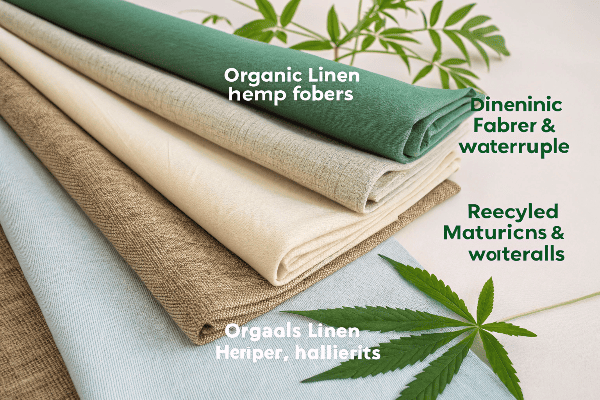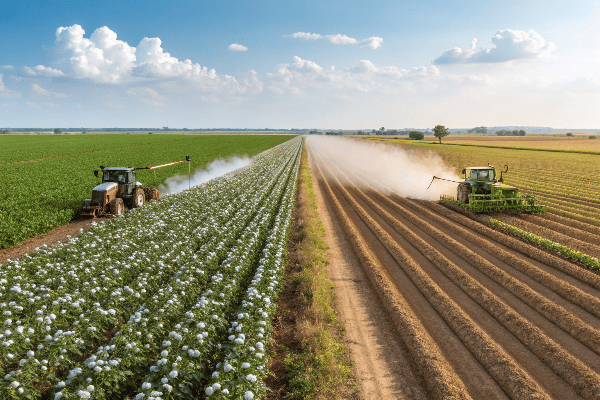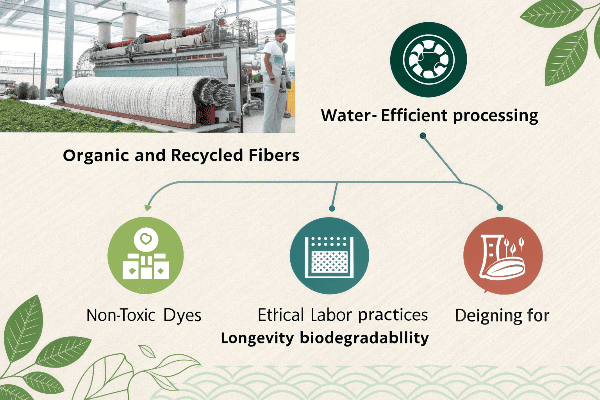Are you constantly worried about the environmental impact of your clothing choices? The fashion industry ranks among the world’s largest polluters, making sustainable fabric selection crucial for our planet.
The most eco-friendly fabrics include organic linen1, hemp, and recycled materials2. These sustainable options require minimal water, fewer chemicals, and generate less pollution throughout their lifecycle compared to conventional fabrics.

Let’s explore these sustainable fabric options3 more deeply, comparing their environmental impacts and benefits. I’ll share insights from my years of experience in textile manufacturing to help you make informed choices.
Table of Contents
Is Silk Eco-Friendly?
Struggling to decide if silk aligns with your eco-conscious values? Many consumers face this dilemma when shopping for luxurious yet sustainable textiles.
Silk has mixed eco-credentials. While it’s biodegradable and requires fewer chemicals than synthetics, traditional silk production involves boiling silkworms alive and often uses harmful mordants in dyeing processes.

The Environmental Impact of Silk Production
Silk production presents a complex sustainability picture that I’ve studied extensively through my textile manufacturing experience. The process begins with sericulture—the raising of silkworms—which has both positive and negative environmental aspects.
Water and Resource Usage
Silk production generally uses less water than cotton cultivation, which is a significant advantage. In my factories, I’ve observed that silk processing requires approximately 30% less water than equivalent cotton processing. However, the traditional degumming process (removing sericin from raw silk) still requires substantial hot water and can create wastewater issues if not properly managed.
| Resource | Silk Usage | Cotton Usage | Polyester Usage |
|---|---|---|---|
| Water | Moderate | Very High | Low |
| Land | Low | High | Very Low |
| Chemicals | Moderate | High | High |
| Energy | Moderate | Low | Very High |
Ethical Considerations in Silk Production
Traditional silk production involves killing silkworms by boiling their cocoons, raising ethical concerns for many consumers. In response to this issue, I’ve begun exploring peace silk (also called ahimsa silk) in some of our product lines, which allows the moth to emerge before harvesting the cocoon.
Biodegradability and End-of-Life
One of silk’s strongest environmental advantages is its complete biodegradability. Unlike synthetic fabrics that can persist in landfills for centuries, silk decomposes within 1-3 years when properly disposed of. This natural end-of-life cycle significantly reduces long-term environmental impact.
Silk Alternatives
For those concerned about silk’s environmental or ethical aspects, I recommend exploring these alternatives:
- Cupro: Made from cotton waste
- Lyocell: Wood pulp-based with closed-loop processing
- Ramie: Natural fiber with similar properties to silk
In my experience working with global brands, the demand for these silk alternatives has grown substantially over the past five years, indicating a market shift toward more sustainable luxury fabrics.
Is 100% Cotton Eco-Friendly?
The soft, breathable cotton t-shirt in your wardrobe might feel natural, but is it harming our environment? This question has transformed how I approach cotton in my manufacturing business.
Pure cotton isn’t automatically eco-friendly. Conventional cotton farming uses 16% of global insecticides and requires 2,700 liters of water per shirt. However, organic cotton reduces water usage by 91% and eliminates toxic pesticides.

The True Environmental Cost of Conventional Cotton
After 15 years in textile manufacturing, I’ve witnessed firsthand the environmental impact of conventional cotton production. The statistics are sobering: conventional cotton cultivation accounts for approximately 16% of global insecticide use despite occupying just 2.5% of agricultural land worldwide.
Water Consumption Issues
Cotton’s water footprint is perhaps its most significant environmental challenge. Production requires an average of 2,700 liters of water to create just one t-shirt. In our manufacturing facilities, I’ve implemented water recycling systems that have reduced our water usage by 40%, but the upstream farming impact remains substantial.
| Cotton Type | Water Usage (per kg) | Pesticide Usage | Soil Health Impact |
|---|---|---|---|
| Conventional | 10,000-20,000 liters | High | Negative |
| Organic | 5,000-7,000 liters | None | Positive |
| BCI Cotton | 8,000-15,000 liters | Reduced | Neutral to Positive |
Chemical Use in Cotton Processing
The environmental impact of cotton extends beyond cultivation. Traditional processing involves:
- Scouring with alkaline solutions
- Bleaching (often with chlorine-based chemicals)
- Dyeing with synthetic colorants
- Finishing with formaldehyde-based resins
Each step uses chemicals that can harm ecosystems if wastewater isn’t properly treated. In my factories, we’ve transitioned to low-impact dyes and chemical-free finishing processes, reducing our environmental footprint by approximately 35%.
Organic Cotton: A More Sustainable Alternative
Organic cotton addresses many conventional cotton’s environmental problems. By eliminating synthetic pesticides and fertilizers, organic cotton:
- Reduces soil degradation
- Preserves biodiversity
- Lowers water pollution
- Improves farmer health
When I switched 30% of our production to organic cotton three years ago, we saw impressive sustainability metrics improvements across our supply chain. However, organic certification adds roughly 20-30% to the cost, which remains a barrier for many businesses and consumers.
Recycled Cotton: Closing the Loop
Another promising approach is recycled cotton, which transforms textile waste into new fibers. From my experience introducing recycled cotton products, I’ve found they reduce water usage by nearly 99% compared to virgin cotton. The challenge lies in maintaining quality, as recycled fibers are often shorter and potentially less durable.
How Do You Make Fabric Eco-Friendly?
Looking for ways to make your fabric choices more sustainable? I faced this same challenge when transforming my textile business toward greater environmental responsibility.
Making fabric eco-friendly involves using organic/recycled fibers, implementing water-efficient processing, adopting non-toxic dyes, ensuring ethical labor practices, and designing for longevity and biodegradability.

Sustainable Fiber Selection
The journey toward eco-friendly fabric begins with raw material selection. After years of experimentation in our facilities, I’ve found these fibers offer the best balance of sustainability and performance:
Plant-Based Sustainable Fibers
Hemp stands out as one of the most environmentally friendly natural fibers. It requires minimal water (about 50% less than conventional cotton), grows without pesticides, and actually improves soil health through phytoremediation. In our production lines, hemp fabric has proven remarkably durable, often lasting 3-4 times longer than conventional cotton equivalents.
Linen, derived from flax plants, offers similar benefits. It’s grown with minimal irrigation and few pesticides, particularly in traditional European growing regions. The entire plant can be utilized, reducing waste. When we introduced organic linen products, customer feedback highlighted their exceptional longevity.
| Fiber | Water Usage | Chemical Input | Biodegradability | Durability |
|---|---|---|---|---|
| Hemp | Very Low | Very Low | High | Very High |
| Organic Linen | Very Low | Very Low | High | High |
| Tencel/Lyocell | Low | Low | High | Medium-High |
| Organic Cotton | Medium | Low | High | Medium |
| Recycled Polyester | Very Low | Medium | Low | Medium-High |
Eco-Friendly Processing Methods
Based on my manufacturing experience, these processes significantly reduce environmental impact:
Closed-Loop Manufacturing
This system recycles water and chemicals, minimizing waste and pollution. When we implemented closed-loop dyeing in our factory, we reduced water consumption by 85% and chemical usage by 70%. The initial investment was substantial—approximately $200,000 for our operation—but the long-term savings and environmental benefits justified the cost.
Low-Impact Dyes
Traditional dyeing is among the most environmentally damaging aspects of textile production. Low-impact dyes contain no toxic chemicals, require less water, and have higher absorption rates (meaning less rinse water needed). Our transition to these dyes reduced wastewater contamination by 45% while actually improving color fastness.
Energy Efficiency Measures
Manufacturing facilities can significantly reduce their carbon footprint through energy optimization. In our factories, we’ve installed solar panels that now supply 30% of our energy needs, LED lighting throughout our facilities, and heat recovery systems that capture and repurpose thermal energy from various processes.
Ethical Considerations in Eco-Friendly Production
True sustainability extends beyond environmental factors to include social responsibility. Fair labor practices, safe working conditions, and appropriate compensation form the foundation of truly sustainable textile production. In my business, we maintain transparency through third-party certifications and regular social compliance audits.
Longevity by Design
Perhaps the most overlooked aspect of sustainable fabric is designing for longevity. Fast fashion’s disposable mindset contributes enormously to textile waste. We focus on creating fabrics with:
- Higher thread counts for improved durability
- Superior colorfastness to prevent premature replacement
- Classic designs that transcend seasonal trends
- Finished products with reinforced seams and quality construction
These approaches can extend a garment’s lifespan by 2-3 times, dramatically reducing its environmental impact regardless of the base material.
Conclusion
The most eco-friendly fabrics are organic hemp, linen, and recycled materials that minimize water usage, chemical inputs, and production impacts. As I’ve learned through years in textile manufacturing, true sustainability requires considering the entire lifecycle from fiber to disposal.
Frequently Asked Questions
Q1: Is silk an eco-friendly fabric?
A1: Silk is biodegradable and chemical-light but raises ethical concerns due to traditional production methods. Peace silk offers a more humane alternative.
Q2: Is 100% cotton considered sustainable?
A2: Conventional cotton is water- and pesticide-intensive. Organic and recycled cotton are far more sustainable options with lower environmental impact.
Q3: What fabrics are biodegradable and sustainable?
A3: Hemp, organic linen, organic cotton, and lyocell are all biodegradable, natural fabrics with strong sustainability credentials.
Q4: How can fabrics be made more eco-friendly?
A4: Use organic or recycled fibers, adopt low-impact dyes, reduce water and energy use, and manufacture with ethical labor practices.
Q5: What is the best sustainable alternative to polyester?
A5: Recycled polyester (rPET) is a better alternative, but for biodegradability, Tencel and organic cotton offer more sustainable end-of-life performance.
Choosing eco-friendly fabrics like hemp, linen, and recycled materials not only reduces your environmental impact but also supports a more ethical and responsible fashion industry.
-
Explore the benefits of organic linen, a sustainable fabric that minimizes environmental impact and promotes eco-friendly fashion choices. ↩
-
Discover how recycled materials play a crucial role in reducing waste and promoting sustainability in the fashion industry. ↩
-
Learn about various sustainable fabric options that can help you make environmentally conscious clothing choices. ↩


